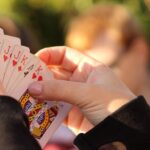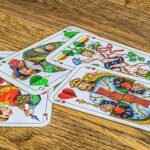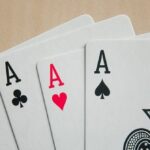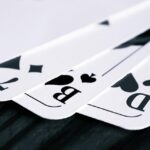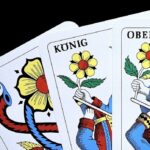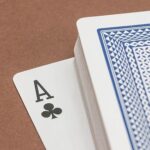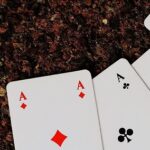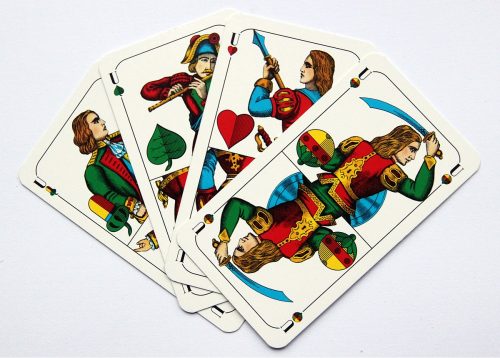 Germany has a strong tradition with respect to card games, as a result the most popular game varies by region.
Germany has a strong tradition with respect to card games, as a result the most popular game varies by region.
Skat, Doppelkopf and Schafkopf are amongst the most popular, they are very similar to each other and pretty tactical. Schafkopf is traditionally played in Bavaria (South-East), Doppelkopf is more popular in the West and North, and Skat originates in the East, but has gain a lot of traction elsewhere since it is the most tactical variant and often played competitively.
Mau Mau is a very simple game which is also popular throughout Germany especially amongst children, UNO is essentially the commercial version of it.
There are many more card games which enjoy local popularity, but may not be known elsewhere. Binokel, Watten, 66 (Schnapsen), Gaigel, just to name a few.
Do you know the names of the suits in German? If not, then here they are!
 Karo (Diamonds)
Karo (Diamonds) Herz (Hearts)
Herz (Hearts) Pik (Spades)
Pik (Spades) Kreuz (Clubs)
Kreuz (Clubs)
An Ace is an Ass. A Jack is a Bube – an old-fashioned German word for “boy.” A Queen is a Dame (which translates to “lady”) and the King is the König (literal translation this time).
Spieler is the word for “player” in German (it’s also the word for “gambler”).
Du bist dran means “your turn.” Unfair (pronounced “oonfair”) means, you guessed it, “unfair.”
Is someone playing dirty in the game? Then yell out, “Hey, du schummelst!” (“Hey, you’re cheating!”)
One-player German Card Games
Auf Wiedersehen
If you’re all by yourself, but still in the mood for a good card game, play a few rounds of the German solitaire game Auf Wiedersehen (Farewell).
To play this game, you need a standard deck of 52 cards. Start with 12 cards laid out face up in three rows of four. Four additional cards are placed face down on the table.
You need to rearrange the cards at the top so that they run from Ace to King. Place the additional cards under the correct suits in order. Now draw a card from the deck and place it where it belongs, if possible. If you pull a King, you can start a new row. Once you’ve finished laying out all the cards you can, turn over the four cards still laying face down on the table. If any of these cards are an Ace or a King matching the top card in the rows, you’ve lost.
Die Farbenelf
The next German card game you can play by yourself is called Die Farbenelf (roughly, “the colorful eleven”).
To play this game, shuffle a standard 52-card deck, then lay out four rows of four cards face up. In these 16 cards, you look for two cards of the same suit with a total value of 11. These pairs can now be laid aside and the gaps filled with new cards taken from the deck.
The Jack, King and Queen can only be removed if they’re taken from the deck at the same time and have the same suit. The goal of the game is to use up the deck and get rid of all the cards.
German Card Games for Groups
Each of the games listed here can be played by two to five players.
Quartett
Quartett (Quartet) is one of the most popular kids’ card games in Germany, and has been for a long time. This game is basically played the same as Go Fish.
The goal is to get four of the same type of card (four sixes in all the suits, for example). Each player asks another player for a card they need to make a set of four. If the player has the card, they have to hand it over. If they don’t have the card, it’s their turn to ask.
Although you can play Quartett with a standard 52-card deck, most kids play with a special deck that features animals facts, trains, planes and automobiles, famous sports stars, etc. These make Quartett the perfect game for learning or practicing basic German vocabulary topics. You can also buy plenty of quirky and/or naughty Quartett decks for a more adult audience, like a Quartett deck of dead rock stars, one featuring addictive substances and, last but not least, the sexy dirndl deck.
Mau-Mau
The German card game Mau-Mau is similar to Uno. Each player is dealt five to six cards. The top card of the deck is then turned over. The player can either lay down a card of the same suit or the same number—for example, a 10 of Diamonds on top of a 10 of Spades.
The goal of the game is to get rid of all your cards. If a player lays down their final card, they have to say Mau, but if their last card is a jack, they have to say Mau-Mau (pronounced like the word “ow” when you hurt yourself, with an “m” in the front).
Böse Dame
Böse Dame (Evil Queen) is similar to the game Hearts, only you want to end the game with high points, not the other way around.
This game is only played with Aces, Kings, Queens, Jacks, Tens, Nines, Eights and Sevens. The points you get for the cards are as follows:
- Ace (11 points)
- Ten (10 points)
- King (four points)
- Queen (three points)
- Jack (two points)
- Nine, Eight and Seven (0 points)
Like Hearts, the Pik Dame (Queen of Spades) is the evil queen here indeed. If you end up with this card at the end, you get -50 points!
You lay down cards of the same suit and the player with the highest card takes the pile. If you don’t have the suit, but you have the Queen of Spades, you can play her and pass her on to another player. If the Queen of Spades is played, you can “stab” her with the King or Ace of Spades. Play this card, and she’ll go back to the person who laid her down.
Longer German Card Games for Groups
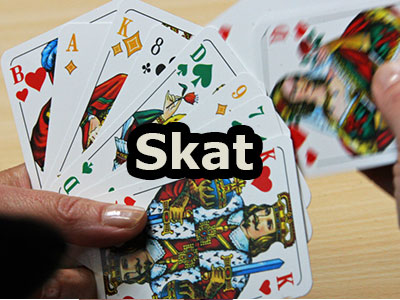
If you really want to get into the world of German card games, there are two words for you: Doppelkopf and Skat.
Both of these popular games can be played for hours. There are many game clubs dedicated to both and they have their own tournaments throughout Germany as well as other German-speaking countries.
Doppelkopf
Doppelkopf (roughly, “double-head”) is a game for four players in teams of two. However, you don’t know who your teammate is until later in the game.
The game is played with 48 to 40 cards and is sometimes played with German-suited cards featuring Balls, Hearts, Leaves and Acorns rather than the standard French-suited cards most of us are used to.
Skat
The other granddaddy of German card games is definitely Skat. Skat is a game for three players and is played with a 32-card deck, either French- or German-suit. The suits have different values, with Clubs or Acorns boasting the highest points, 12.
